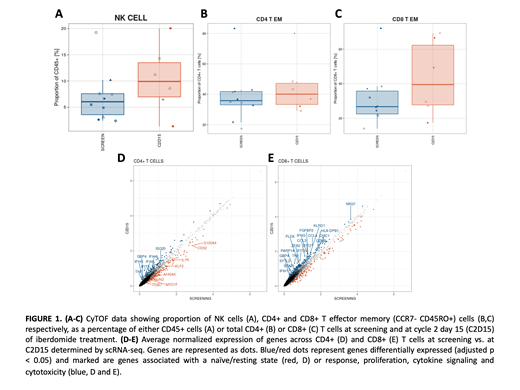Background: Iberdomide (IBER), a novel cereblon (CRBN) E3 ligase modulatory compound (CELMoD), is being evaluated in a phase 1/2 clinical trial for treatment (tx) of RRMM, as a monotherapy, in combination with low-dose dexamethasone (DEX), or in combination with DEX and daratumumab, bortezomib, or carfilzomib (CC-220-MM-001; NCT02773030). IBER modulates the CRBN E3 ligase, inducing ubiquitination and proteasome-dependent degradation of Ikaros, Aiolos, and ZFP91, resulting in inhibition of myeloma-cell growth and immunomodulation.
Methods: As of June 28, 2019, 95 patients (pts) had received IBER as monotherapy or in combination with DEX at doses ranging from 0.3 to 1.3 mg taken once daily (QD) on Days 1-21 of 28-day cycles (21/28). Longitudinal immune profiling by peripheral blood (PB) flow cytometry was completed at Cycle (C) 1 Day (D) 1 and C2D15 in 90 pts dosed up to 1.3 mg. T cell and NK cell proliferation was assessed by Ki67 staining and T cell activation was assessed by HLA-DR expression. T cell differentiation was assessed using markers for CD45RA, CD45RO, and CCR7. To assess immune changes in the bone marrow (BM) microenvironment, viably frozen CD138- cells from BM aspirates were obtained from pts at screening and C2D15 (10 and 6 samples available respectively; dosed from 0.3 - 0.9 mg). Samples were analyzed using both single-cell RNA sequencing (scRNA-seq) and mass cytometry by time-of-flight (CyTOF) with a novel panel designed to identify B cells, T and NK cell (sub)populations, monocytes, dendritic cells, MDSCs and Tregs. An R based workflow using the CATALYST (Crowell et al. 2019) and Seurat package (Stuart et al. Cell 2019) was used to analyze CyTOF and scRNA-seq data, respectively.
Results: PB immune profiling of pts showed increases in total and proliferating NK cells following IBER tx across all doses (median increase = 35.5% and 74.2%, respectively). A dose-dependent increase in proliferating, activated and effector memory CD4+ (median increase = 92.3%, 45.5%, 51.7%, respectively, across all doses) and CD8+ (median increase = 116.0%, 13.9%, 45.8%, respectively, across all doses) T cells was also observed. To understand if these changes were concurrent with changes in the tumor microenvironment, a novel CyTOF panel was produced to analyze BM samples. Analogous to the PB findings, total BM NK cells increased (6.05% cells at screening vs. 9.91% at C2D15). CD16+ NK cells, known for their cytolytic activity, increased most prominently (35.9% of NK cells to 42.4%) vs. CD16- NK cells (64.1% of NK cells to 57.6%). Higher median CD16, CD56 and HLA-DR surface expression at C2D15 was also observed vs screening, demonstrating increased abundance and differentiation of NK cells. Similar to observations in the T cell compartment of PB, decreases in naïve CD4+ (24.4% to 9.09% of CD4+ cells) and CD8+ (6.42% to 2.14% of CD8+ cells) T cells and increases in effector memory CD4+ (35.8% to 40.1%) and CD8+ (26.7% to 39.5%) T cells were observed in BM. Transcriptomic data in BM showed increased expression of genes associated with cytolytic/cytotoxic activity (NKG7, GZMB, CCL3/4) and the interferon response pathway (IFNG, TNF, IFIT2/3) in CD8+ T cells, further supporting a shift towards activation in BM T cells with IBER tx. Conversely, we observed decreased expression of genes associated with a resting state (KLF2, ITGB7, CD52, S100A4) on CD4+ T cells in BM. Consistent with data from PB and of other immunomodulatory drugs, we also observed an increase in CD4+ regulatory T cells upon tx (0.72% to 5.06% of CD4+ T cells) in BM, however, the consequence of this observation in terms of response remains unclear.
Conclusions: Pharmacodynamic profiling of immune subsets in PB and BM of RRMM pts receiving IBER showed consistent changes in NK cells and T cell subsets, suggesting increased proliferation and a more activated phenotype. Ongoing analyses will address whether such patterns of immune cell responses are more pronounced at higher doses of IBER and how they may correlate with clinical outcome.
Amatangelo:Celgene Corporation: Employment, Equity Ownership. Gooding:Celgene: Research Funding. Oppermann:Bayer Pharmaceuticals: Research Funding; GSK: Research Funding; Celgene: Research Funding. Pierceall:Celgene: Employment. Thakurta:Celgene: Employment, Equity Ownership. Parekh:Karyopharm Inc.: Research Funding; Foundation Medicine Inc.: Consultancy; Celgene Corporation: Research Funding.
Author notes
Asterisk with author names denotes non-ASH members.


This feature is available to Subscribers Only
Sign In or Create an Account Close Modal